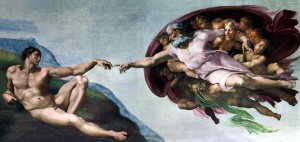 After birth of human civilization began one of the most important processes of human culture – the process of creating beauty. Today we can call it “art”. What was art for a human before? What was the art’s role in the development of practical inner world?
After birth of human civilization began one of the most important processes of human culture – the process of creating beauty. Today we can call it “art”. What was art for a human before? What was the art’s role in the development of practical inner world?
Far past left it’s footprints for posterity. History has preserved in our memories all complexities and contradictions in defining moral values ??that human beings at every stage of development of society. Fear and passion, longing and love, sadness and joy, our ancestors, just as we, have tried to convey. It can be seen from the first cave paintings up to the most advanced graphic. You can see, hear, to touch … We associate the art with something beautiful. It is, in my opinion, it should be the first at list of synonyms to the word “beauty”.
Art gives us the opportunity to experience of moral things being. We can see how a particular person – the creator, or a group of people imagine the environment. That means visual arts help to people understand any issue that bothers many generations. Writers, musicians, artists … All they are saying that care and makes sense.
When an artist gives to his feelings vent – he creates a fantasy image for us. The image of love, the image of suffering; image of work, way of thinking, the image of the imaging … All that inspire artists – is life. And what is life? This is combination of different content and content problems that make people to wake up every day, fight, go ahead.
These moral issues vary from going ages, culture and social fabric of the state. But all they touch our souls. Moral values ??each person defines for themselves. But all of them are typical: family, friendship, love … Some specific, others – abstract. But – it is our moral issues that we decide, walking paths of our lives. And where we step? We go in a certain direction, seeking the sense of our lives, personal happiness, sometimes about social welfare.
Do we like it or don’t, art is closely connected with morality. All information that we see in works of art – are a source of moral convictions from the author to us. Values ??spiritual experiences, good and evil in the endless struggle – all this is another proof that without morality wouldn’t be art. Because art – only product of spiritual (moral) human.
There is also a feedback morality and art. Art, in turn enriches the human moral potential new emotions, impressions and feelings. So, in a close relationship, art and morality accompany us from birth to death. Yesterday, today and tomorrow we are interested in all the same questions, but with a different depth. The perspective of human development, the state, the international community – are the eternal problem. Fuel for their movement is morality, which in turn draws energy from art.
Each creator, in my opinion, in process of creating another masterpiece, designed for those, “What emotions will my work cause at people?” That is, the artist or composer seeks out certain colors or music that can cause us a manifestation of morality – a smile or away tears.
With the passage of time and changing eras appear new styles and current art. And each style – baroque, classicism, symbolism or futurism – became a new understanding of new problems. Each style becomes part of something new, interesting and unusual art. The whole history of art, if you imagine it as a coherent evolution – are gradual movement aesthetic consciousness approach to understanding life.
But, like about art is not close to the disclosure of the meaning of life, real life is always richer and brighter in hundred times. Young artists, writers, composers continue to represent only the images but not life itself. We should not forget that the process of creation of art and its content, in any case, remain outside the moral content.
Features an expression of true art, especially the art of complex epoch, which had a huge variety of philosophical principles and scientific discoveries are not concessions system in which ethical theory creates moral norms and principles. Artistic personality style reveals subjectivity world – the author’s vision of the world. So it certainly leaves its mark on the riot of colors figurative art.
However, I would like to equate art and morality. After all, unlike art, morality aims to objectify and generalize. Ethics forms the semantic structures that are close to universality. What I personally think is right.
The music speaks about life and death, good and evil, love and about nature. It conveys the process of creation and destruction, dynamic eternity. Fabrics artists claim that moral perfection and aesthetic beauty have much in common. The word evokes images of the human soul in love, relationship drama, harmony and human emotions. It is located at a certain distance from morality, but is not separated from it.
I would like to recall the words of the famous Ukrainian teacher Vasyl Sukhomlinsky, about morally educated person should know morality, and adhere to these principles; consider features, feelings and interests of others; be able to recognize the situation from the position of another person and still have the ability to defend their beliefs.
So, in conclusion, I can say only one thing: morality and art complement each other. And this close relationship gives to us spiritual harmony in this enormous Universe.
